2025.07.23
Puffer fish– The Dangerous Jewel of Japanese Haute Cuisine: Fugu
By Chef Yuuki Tanaka, owner of Ise Sueyoshi — Tripadvisor Best of the Best: Japan #1, World #12.(source).
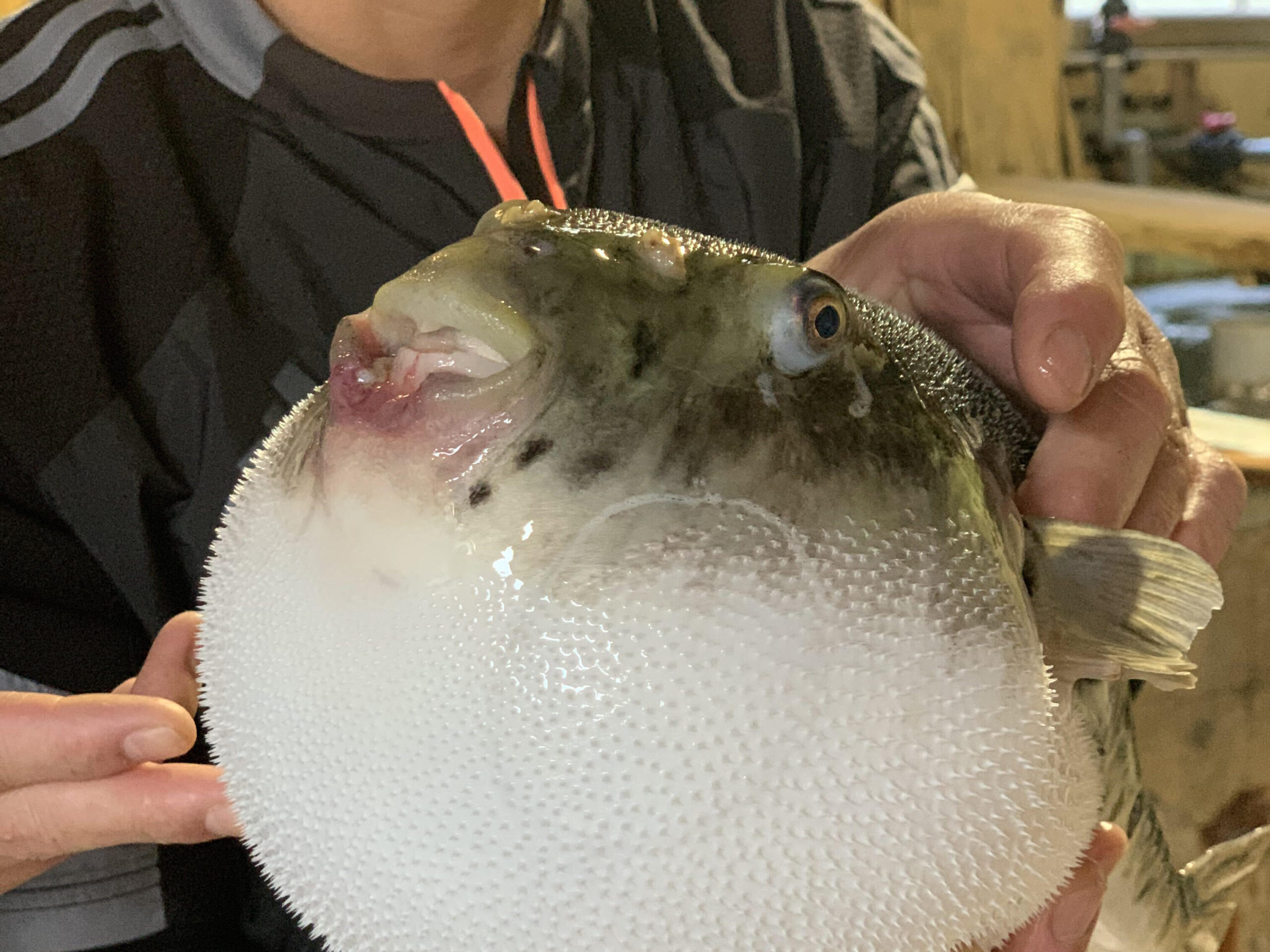
What You’ll Learn in This Article
• What Fugu (blowfish) is and why it’s so iconic in Japanese cuisine
• The risks and regulations surrounding fugu preparation
• How top chefs in Japan handle fugu safely and skillfully
• What makes wild fugu from Mie Prefecture so special
• How Ise Sueyoshi features fugu in their seasonal kaiseki course
Fugu: The Poison Fish Mystery
What comes to mind when you hear the term puffer fish?
Around the world, many people associate it with danger—a poisonous fish that should never be eaten. And yet, in Japan, this very fish is prized as one of the most luxurious ingredients in high-end cuisine. Known locally as fugu, it holds a unique place in Japanese culinary culture.
In Japan, fugu is often described as “a dish you entrust your life to.” Preparing it requires deep trust, as well as precise knowledge and exceptional skill. Only chefs who hold a national license are legally permitted to handle it, making fugu cuisine a rare delicacy reserved for special occasions.
The translucent slices of sashimi, the pure white flesh, and the delicate interplay of texture and umami—all of these elements transform fugu into a carefully calculated expression of beauty. In Japanese culture, fugu is not merely food. It is a work of culinary art that captures the extremes of “danger” and “delight” on a single plate.
Value changes across cultures.
While fugu may be feared in many parts of the world, it is honored in Japan as a refined dish for celebration. This is not a contradiction, but a symbol of cultural diversity and the vast potential of gastronomy.
In this article, we will delve into the rich traditions surrounding fugu in Japan—from its cultural significance and culinary techniques to the philosophy behind its preparation.
Why do the Japanese treasure this perilous fish so deeply? Let us take you on a journey into the mystery of fugu—and to the very heart of Japanese cuisine.
Mastering Life
Fugu is not just an expensive delicacy—
It is a rare ingredient that holds a dangerous duality: exquisite flavor and deadly poison. Only through the mastery of life itself can this fish safely make its way to the dining table.
Historically, even in Japan, fugu was seen as a dangerous fish. During the Warring States period, Toyotomi Hideyoshi—who unified Japan—banned the consumption of fugu to protect his retainers from its lethal effects. In the Edo period, fugu cuisine began to quietly resurface in various regions. However, it was only in modern times that fugu was officially approved and established as a part of Japan’s culinary culture.
Today, Japan maintains some of the strictest regulations in the world for the handling and serving of fugu.
Chefs must obtain a special Fugu Preparation License (fugu chōrishi menkyo), a state-level qualification issued by each prefecture. Earning this license is no simple task.
The process consists of two major exams—but even before attempting the tests, candidates must prove a minimum of two years of hands-on experience under a certified fugu chef. It’s not enough to simply know the science and techniques—one must understand the tension and responsibility of working in real kitchens.
The two main examinations are:
- Written Exam: Covers an extensive range of knowledge including toxic parts of the fish, safe handling methods, and food poisoning prevention.
- Practical Exam: Requires the candidate to demonstrate the actual preparation of fugu, accurately removing the poisonous organs and transforming the fish into a safe and edible ingredient.
Thanks to this rigorous licensing system, diners in Japan can enjoy fugu with confidence.
Since the implementation of these standards, fugu-related food poisoning cases have dropped dramatically. Today, nearly all incidents are caused by unlicensed home preparation—not by trained chefs. In other words, the system ensures that properly prepared fugu is indeed safe.
This system also demands that chefs possess a deep sense of responsibility—the awareness that they are handling life itself.
Chef Yuuki, the head chef at Ise Sueyoshi, is among the few licensed fugu chefs in Japan. With each day of service, he approaches every ingredient with utmost sincerity, continuously engaging in the act of “transforming life into flavor.”
Fugu is not just about taste.
It is about the pride and integrity of those who dare to prepare it.
This is the essence of fugu cuisine in Japan.
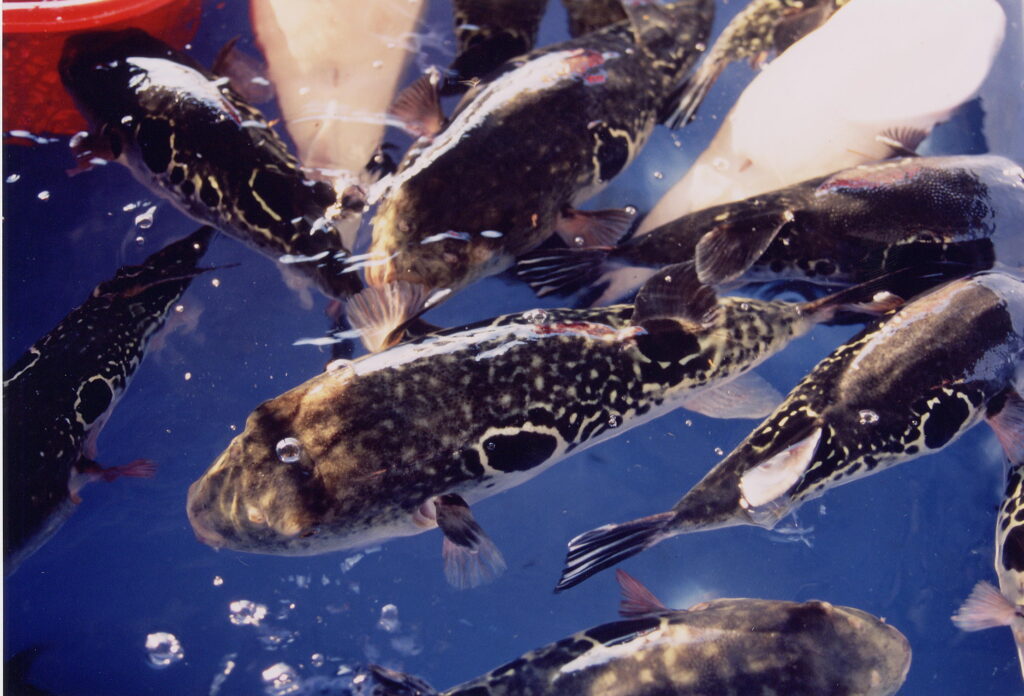
License & Legacy
The most defining trait of fugu is its possession of tetrodotoxin, a potent neurotoxin.
This toxin is concentrated in organs such as the liver, ovaries, and intestines, and even a minuscule amount can be fatal. Because of this, preparing and serving fugu safely requires far more than culinary skill—it demands strict adherence to legal protocols and highly specialized techniques.
In Japan, fugu’s toxic parts are regulated with the same level of control as pharmaceutical substances.
Once removed during preparation, these poisonous organs must be sealed in locked, dedicated containers, kept entirely separate from general waste. They are then collected and disposed of by licensed disposal companies, ensuring they never enter the food chain or are handled improperly.
Additionally, any chef responsible for preparing or managing fugu must hold a prefectural fugu preparation license. This is not a mere formality—it is a rigorous certification that evaluates the individual’s knowledge, technique, and experience. Even after acquiring the license, chefs are expected to uphold the highest standards of skill and accountability.
Violating these regulations—or worse, causing even a single food poisoning incident—can lead to severe consequences, including suspension of business, arrest, and public exposure by name in the media. For fugu chefs, this means every day at work comes with a profound sense of tension, responsibility, and ethical duty.
Yet, precisely because of this gravity, holding a fugu license is a source of deep pride for Japanese chefs. It is a symbol of trust, tradition, and mastery.
Fugu cuisine is not just a meal—it is the culmination of a culture that has long faced the realities of life and death head-on, expressing that journey through its food.
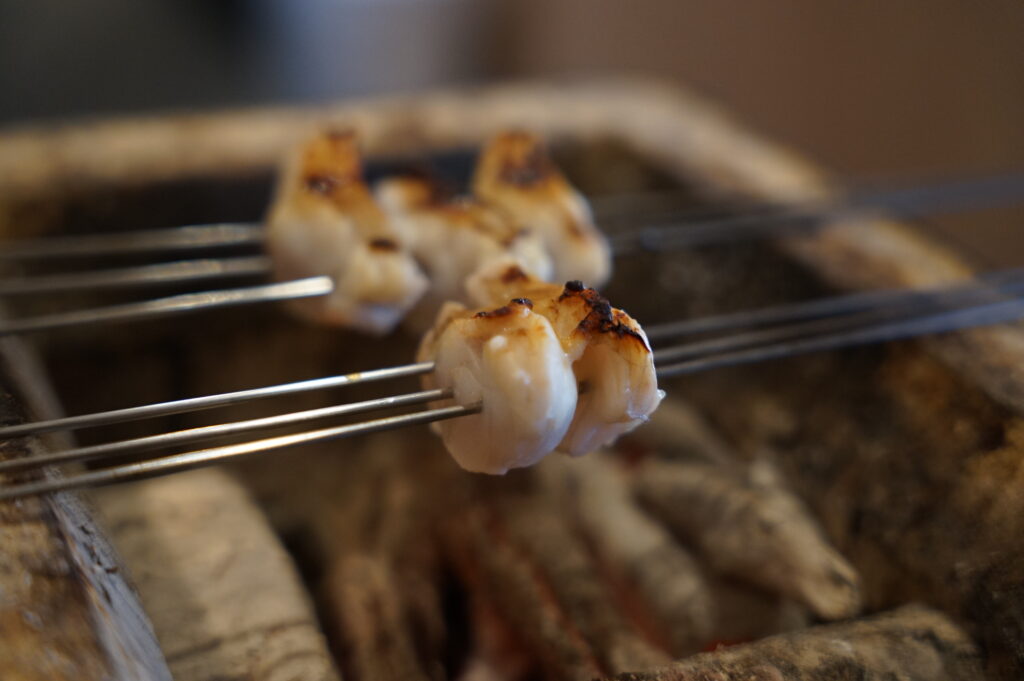
Flavor in Finesse
Fugu—the fish beloved by the Japanese for generations—is difficult to describe with just one word.
This is because its appeal doesn’t lie in bold, immediate impact, but in its refined umami and delicate texture.
The flesh of fugu is exceptionally mild in flavor, yet the more you chew, the more you uncover a gentle sweetness and subtle depth. What truly distinguishes it, however, is its unique texture—a supple yet chewy mouthfeel found in no other fish. Its lean, slightly firm meat has a springy resilience that seems to softly adhere to the tongue, making each bite an experience in itself.
This paradoxical balance of firmness and tenderness transforms further depending on the cooking method.
As thin sashimi (usuzukuri), it offers both visual elegance and refined smoothness on the palate.
As karaage (Japanese-style deep fry), it releases its rich umami with every bite.
In hot pot (nabe), it harmonizes with other ingredients while enhancing the broth with an elegant depth.
Rather than overwhelming your taste buds, fugu teaches you how to taste—to slow down, focus, and savor each mouthful with intent.
In that quiet act of concentration, food becomes art.
That is the true charm of fugu: a flavor that marries quiet strength with refined grace.
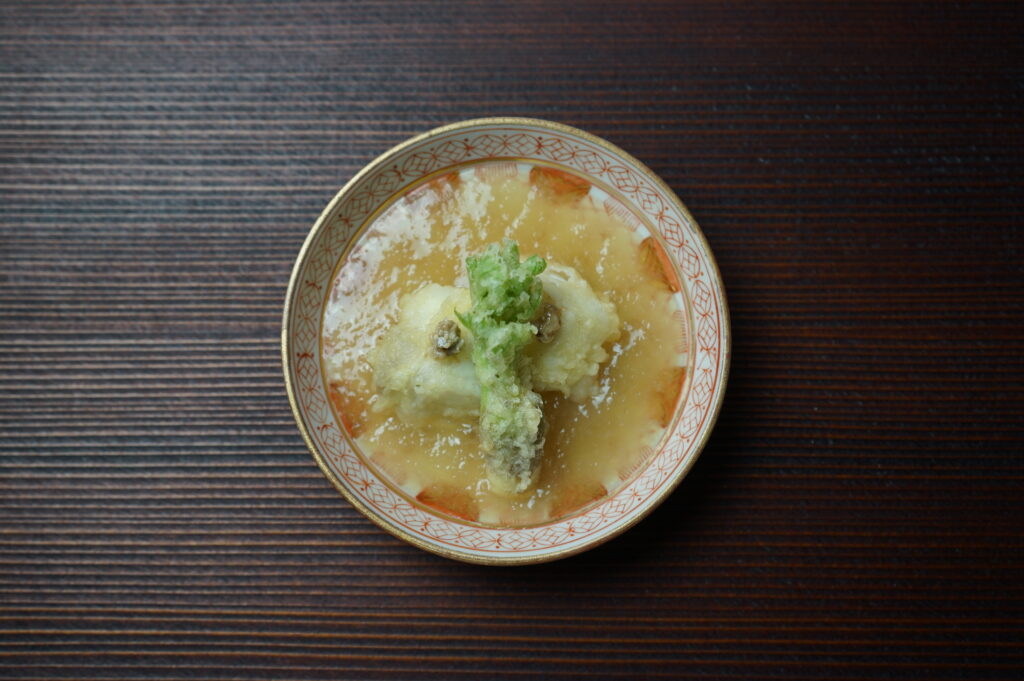
Faces of Blowfish
Fugu is a remarkably versatile ingredient, capable of expressing completely different personalities depending on how it is prepared. Its subtle flavor and signature texture never overpower, yet always leave a lasting impression. At Ise Sueyoshi, we showcase the full spectrum of fugu’s potential through a variety of carefully curated dishes.
We begin with “Tessa”—thin slices of raw fugu sashimi, nearly transparent and artfully arranged. The moment they touch the tongue, you experience a gentle elasticity and an elegant, faint sweetness. It’s a quiet kind of delight—as if you’re listening with your palate.
Next comes deep-fried fugu (karaage), which offers a striking contrast. Crisp on the outside and juicy within, each bite releases layers of umami. The fibrous texture unique to fugu provides a satisfying chew not found in other fish.
Grilled fugu is another standout. Lightly seared over charcoal, the crisped skin and smoky aroma create a beautifully balanced flavor. It’s a deceptively simple dish that reveals the true skill of the chef and the quality of the fish.
At the end of the course comes our signature fugu broth porridge (zōsui). Made by slowly simmering fugu bones to extract their full essence, this comforting dish brings together seasonal vegetables and rice, offering a deep sense of calm. It is the final masterpiece, rounding out the dining journey.
In winter, we also serve hirezake, a traditional hot sake infused with grilled fugu fin. Its smoky aroma and warming depth of flavor create a soothing experience that lingers in both body and soul.
At Ise Sueyoshi, we incorporate just one fugu dish into our ten-course kaiseki menu—always in the form best suited to the season. Whether raw, fried, grilled, or in broth, each preparation reveals a new face of this remarkable fish.
The charm of fugu cannot be captured in a single dish.
It is a multifaceted ingredient—one that inspires creativity in the chef and leaves a deep sensory impression on the guest.
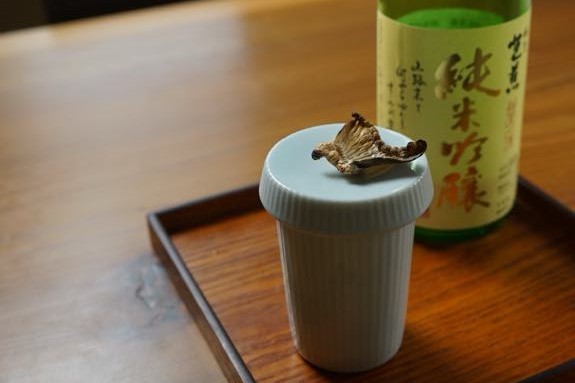
The Art of Slice
The most delicate way to appreciate the beauty of fugu is through sashimi—specifically, tessa, the paper-thin slices of raw fugu. Among all Japanese culinary techniques, tessa is considered one of the most refined and technically demanding. It is far more than just “slicing raw fish.”
Tessa is typically served so thin that the plate beneath it is visible through the translucent flesh. Achieving this level of precision while maintaining uniform thickness demands not only masterful knife skills but also an intimate understanding of the fish’s muscle fibers. To slice fugu—firm in texture—into beautiful, smooth, and tender pieces requires years of disciplined training.
This act of slicing transcends mere technique; it is an expression of the chef’s aesthetic philosophy. Once arranged on the plate, tessa often resembles the petals of a chrysanthemum, forming a dish that feels as much like a piece of visual art as a culinary one.
It is a multisensory experience, engaging not only taste but sight, touch, and even the surrounding atmosphere. In today’s world, very few food cultures still embody such a deeply held philosophy around the act of slicing.
And it is through this method—this precision of the blade—that the subtle umami and unique texture of fugu are revealed in their purest form.
At Ise Sueyoshi, we serve tessa sliced just slightly thicker than the traditional style, to highlight the satisfying chewiness and depth of flavor. In some preparations, we gently sear the surface to add a hint of smokiness, introducing a new dimension to the dish.
The sharpened sensibility embedded in the act of slicing—
It brings forth a quiet yet profound emotion that cannot be reached by taste alone.
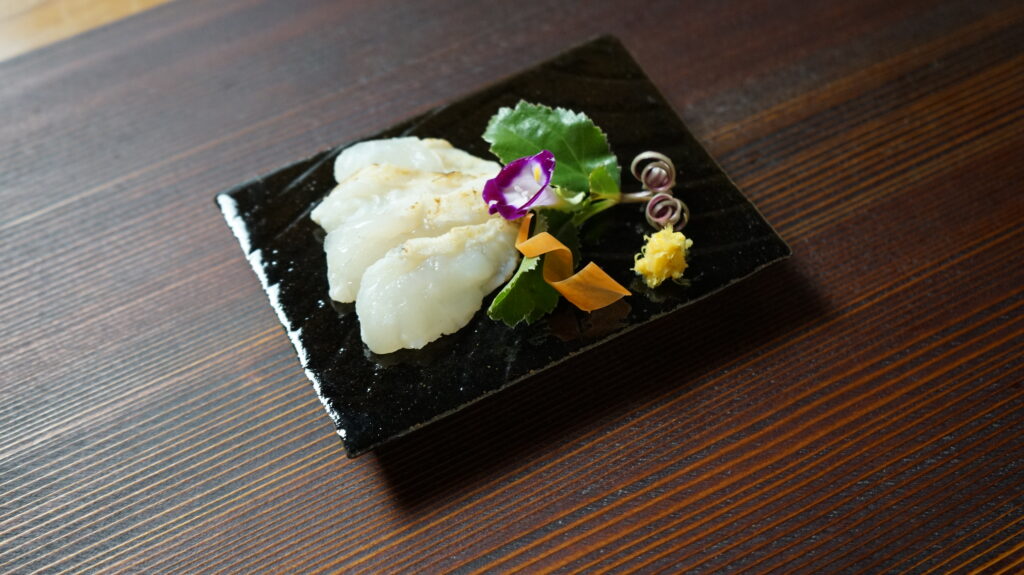
Magic of Fry
Another captivating way to enjoy fugu is through karaage—Japanese-style deep-frying. In contrast to the delicacy of thinly sliced sashimi, frying offers a bold and dynamic method that enhances the natural texture and umami of the fish.
Fugu is a virtually fat-free fish. Its clean, subtle flavor holds up well to heat and seasoning, making it an ideal candidate for frying. The lack of fat allows the fish to absorb the richness of the oil without becoming greasy, while the crispy batter contrasts beautifully with its springy, meaty interior.
At Ise Sueyoshi, instead of small bite-sized pieces, we fry slightly larger chunks of fugu. This lets guests fully experience its uniquely “meaty” texture. The outside is perfectly crisp; the inside, tender and juicy. It’s the ultimate harmony of crunch and succulence.
Different parts of the fish offer varied delights.
The body flesh is soft and refined in flavor, while the kama—the collar section near the head—is more gelatinous, rich in umami, and offers a satisfying chew. This area contains natural collagen, resulting in a pleasantly bouncy texture and a burst of flavor with each bite.
We sometimes serve two variations of fugu karaage together on a single plate:
- Salted Karaage: Lightly seasoned fugu meat, highlighting its natural flavor.
- Soy-Marinated Collar Karaage: The richer, more flavorful kama section, marinated in a soy-based sauce before frying.
The contrast between the two presents a delightful range of flavors and aromas, showcasing the incredible depth that can be drawn from just one fish.
Deep-frying, in this case, works like magic—
It transforms the fish, unlocking textures and tastes that raw preparation alone cannot reveal. It is a sensory experience, both comforting and exciting, that elevates fugu to another level.

Charcoal Harmony
One of the most refined ways to draw out the essence of fugu is through charcoal grilling. The combination of fire and fragrant smoke reveals a deeper dimension of this remarkable fish.
Naturally low in fat and rich in subtle umami, fugu’s flesh responds beautifully to high heat. When grilled quickly over a hot flame, the surface develops a crisp, smoky char, while the interior remains moist and tender. This contrast creates a layered flavor experience that other cooking methods simply cannot replicate.
The secret lies in the power of charcoal. The far-infrared heat radiating from the embers sears the surface while gently cooking the inside, preserving fugu’s signature chew and natural juiciness. The delicate aroma of the charcoal adds an elegant accent to the fish’s clean flavor, making it a perfect pairing with premium Japanese sake.
At Ise Sueyoshi, we insist on grilling each piece of fugu fresh over charcoal and pairing it with a light broth. Grilled just moments before serving, the dish is presented sizzling hot, right before your eyes. That fleeting moment—when the aroma rises and the flavor reaches its peak—is when the spirit of fugu truly comes alive.
The grilled fragrance that emerges only with fire.
The springy texture that intensifies with heat.
Charcoal-grilled fugu is a quiet dialogue between ingredient and flame—
a dish that embodies the pinnacle of indulgence.

Umami Preserved
The perfect finale to a fugu meal—Zosui, a Japanese-style rice porridge infused with the full essence of the fish.
The broth, slowly extracted from fugu bones, is astonishingly rich in umami despite its lightness and clarity. Fugu is a naturally lean fish, but its bones, skin, and flesh contain abundant collagen and natural savory compounds. As these elements simmer in the pot, they release a depth of flavor that no other fish can match, resulting in a broth that is both mellow and deeply nourishing.
When rice is gently added to this broth and simmered over low heat, the result is zosui: a dish that captures the very soul of fugu. To enhance the richness, we also add flakes of tender fugu meat and supple, collagen-rich skin. These additions create layers of texture and elevate the dish to something truly luxurious. It is, quite literally, the essence of fugu in its purest form.
At Ise Sueyoshi, we sometimes enrich the experience even further by topping the zosui with fugu shirako—its milt—one of the most prized, creamy delicacies of the fish. As the shirako melts into the broth, it transforms the zosui into a silken, indulgent conclusion to the meal, delivering a sense of satisfaction and elation rarely found at the end of a course.
From the first bite to the last drop, the journey of fugu unfolds—
And in this final bowl, its story comes to a gentle, unforgettable close.
A quiet accumulation of flavor drawn patiently over heat—
This is the art of umami, preserved.
Fugu Fin Sake
The enjoyment of fugu does not end with the final bite.
There is one more exquisite experience to be savored: Hirezake—a traditional Japanese way to deepen the afterglow of the meal.
Hirezake is made using the fin of the fugu.
First, the fin is meticulously washed with salt to remove any impurities or bitterness. It is then carefully split and air-dried until crisp. Just before serving, it is lightly grilled over an open flame—a delicate step that draws out its rich aroma through artisanal precision.
The sake, gently warmed to the perfect temperature (never overheated, lest it lose its character), is poured into a lidded cup with the charred fin. In front of the guest, the lid is lifted and a flame is briefly applied—flambé.
As the fire rises, a burst of toasty aroma fills the air.
The alcohol flashes off, and in its place remains a rich infusion of fugu essence. The result is a drink like no other: a deep, umami-laden sake that could be described as a “drinkable dashi.”
Hirezake is not simply a warm drink—it is the culmination of the fugu experience.
For centuries, the Japanese have cherished this pairing as something sacred and rare, a final chapter that lingers long after the meal ends.

At Ise Sueyoshi, we sometimes serve this pairing as part of a fugu-centered story.
The rising aroma before your eyes, the savory warmth that fills your palate, and the gentle satisfaction that settles in your chest—this is not just a drink, but an epilogue of fragrance and memory.
Hirezake is, in every sense, the art of savoring the afterglow.
Read more about Sake Pairing:
Enhance Your Kaiseki Experience in Tokyo: Sake Pairing for Ultimate Satisfaction
Gifts from Mie
Though located in the heart of Tokyo’s Roppongi district, Ise Sueyoshi sources wild-caught tiger pufferfish (torafugu) directly from Anori in Shima City, Mie Prefecture.
While most fugu available today is farm-raised, we are deeply committed to serving only wild-caught fugu.
Wild fugu reflects the subtle changes of the seasons—its fat content, texture, and flavor evolve naturally with the rhythm of nature. The result is an experience that is both authentic and exceptional in taste and texture.
In winter especially, torafugu nurtured by the cold waters and strong currents of Ise Bay develop firm flesh and deeply concentrated umami.
The fugu we procure are caught with care by Anori fishermen using line-fishing and fixed-net methods.
Their seasoned eyes, honed techniques, and intuitive relationship with the sea—factoring in daily weather and tides—are essential to ensuring the highest quality.
The journey of this fish is more than a matter of logistics; it is a flow of heart—an invisible chain of trust, respect, and craftsmanship.
At Ise Sueyoshi, our monthly 10-course kaiseki menu includes one fugu dish, offered in a seasonal style.
From sashimi (tessa) to karaage, charcoal-grilled, or in a comforting porridge (zōsui), the preparation changes each month to reflect the moment’s peak.
Of course, fugu is only one part of our culinary story.
We also feature meticulously selected ingredients such as wagyu, tuna, Ise lobster, and seasonal vegetables—each dish crafted with narrative and heart.
Our mission is to capture the essence of Japanese cuisine—through technique, through emotion, through the connection between ingredient and guest.
From the ocean of Chef Yuuki’s hometown in Mie to the table in Tokyo,
each bite carries with it the entire journey—one that stays with you, long after the meal is over.
Read More about Ise Ebi Lobster
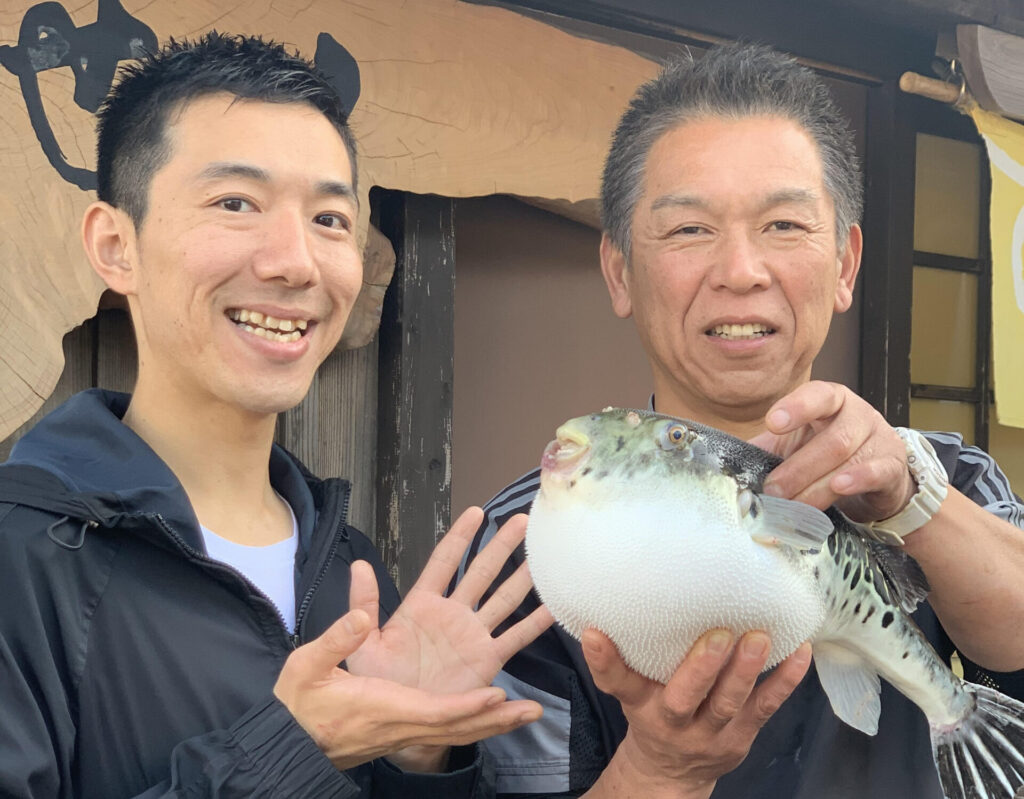
Kaiseki Chef Yuuki
Chef Yuuki Tanaka, head chef of Ise Sueyoshi, was born and raised in Mie Prefecture, Japan.
Growing up in the kitchen of his father’s restaurant, the sound of a knife against a cutting board was simply part of everyday life. With these early memories etched into his heart, he set out to become a chef and eventually opened Ise Sueyoshi in Tokyo’s Roppongi district—a sanctuary for global gourmets seeking the soul of Japanese cuisine.
Every ingredient and every bottle of sake served at Ise Sueyoshi is sourced from his home region of Mie.
But Chef Yuuki’s dedication goes beyond sourcing: he personally visits every farm, every fishery, and every producer.
He listens, observes, and builds lasting relationships—ensuring that the passion of the producers flows directly to the guest’s plate.
In the restaurant, you’ll find a small book titled “Flow of Heart.”
It tells the stories of these producers—their struggles, philosophies, and dreams—and embodies Chef Yuuki’s belief that ingredient, emotion, and respect must flow together.
“How can I circulate the life of this ingredient?”
“How can I make it shine its brightest?”
These questions form the core of his culinary philosophy—infused into every dish he creates.
His technique and sensibility have earned acclaim from connoisseurs and chefs around the world.
“I’ve never had fugu before, but this was incredible.”
“The tuna came back to me in a dream.”
“This Kaiseki is not food—it’s art.”
Such praise speaks to the passion and artistry behind every plate.
Fugu is a notoriously delicate and dangerous ingredient—one that demands skill, humility, and absolute precision.
Chef Yuuki accepts that responsibility with resolve, transforming pressure into poetry.
Every dish is more than a meal—it is a story of life, risk, and reverence.
That is the spirit, and the discipline, of Kaiseki Chef Yuuki.
Read More about Chef Yuuki
The Story of Tokyo’s Best Chef, Yuuki Tanaka: Bringing the Blessings of His Hometown to the World
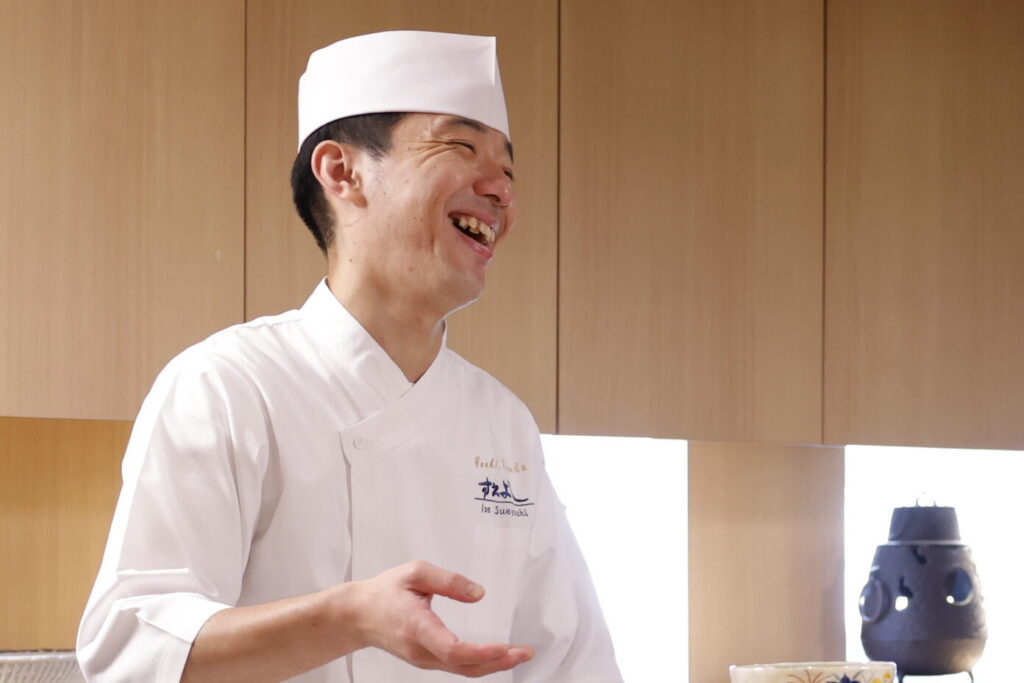
What is Kaiseki?
Kaiseki, regarded as the pinnacle of Japanese cuisine, is far more than just a meal. It is an immersive experience of “eating the seasons,” a uniquely Japanese aesthetic that engages all five senses. Even during tsuyu—the rainy season—kaiseki incorporates subtle seasonal touches that gently and deeply resonate with each guest.
Take, for example, the appetizer of the day: Amadare Shizuku (“Raindrop Essence”). Guests are invited to gently pour a clear, dashi-based broth into their bowl—evoking a raindrop collecting on a lotus leaf. Inside await delicate ingredients such as silky yuba (tofu skin), tender simmered prawn, and sweet, ripe tomato—each representing the fresh and vibrant essence of tsuyu. It is a dish completed not only by flavor but by the moment of interaction, transforming the guest into part of the creation.
The hassun course, titled Ajisai Shitate (“Hydrangea Style”), is served in a glistening glass bowl adorned with seasonal green maple leaves. It features a dumpling shaped like a hydrangea bloom and a softly sweet green plum preserved in syrup. Visually refreshing, this course invites the diner to experience the season even before the first bite.
The main dish centers around the seasonal delicacy of Kuwana hamaguri (Japanese clams), served two ways: shabu-shabu and nyumen (thin noodles in broth). The clams are gently simmered in a special dashi until their shells softly open—the precise moment they reach their peak flavor. Guests savor the plump, juicy meat first, followed by the clam’s umami-infused broth transformed into a comforting bowl of noodles. A luxurious two-part dish that captures the very soul of the season.
Finally, the dessert—Mizu Manju—brings the meal to a gentle close. With its crystal-clear jelly and smooth red bean filling, it mirrors the quiet elegance of a rainy day, leaving behind a lingering sense of calm and sweetness.
With its subtle aromas, textures, and quiet rituals, kaiseki in tsuyu expresses the beauty of rain in its most refined form. Rather than viewing rain as gloomy, kaiseki teaches us to cherish it as a gift from nature. Through these seasonal dishes, we invite you to discover the peaceful, poetic charm of Japan’s rainy season.
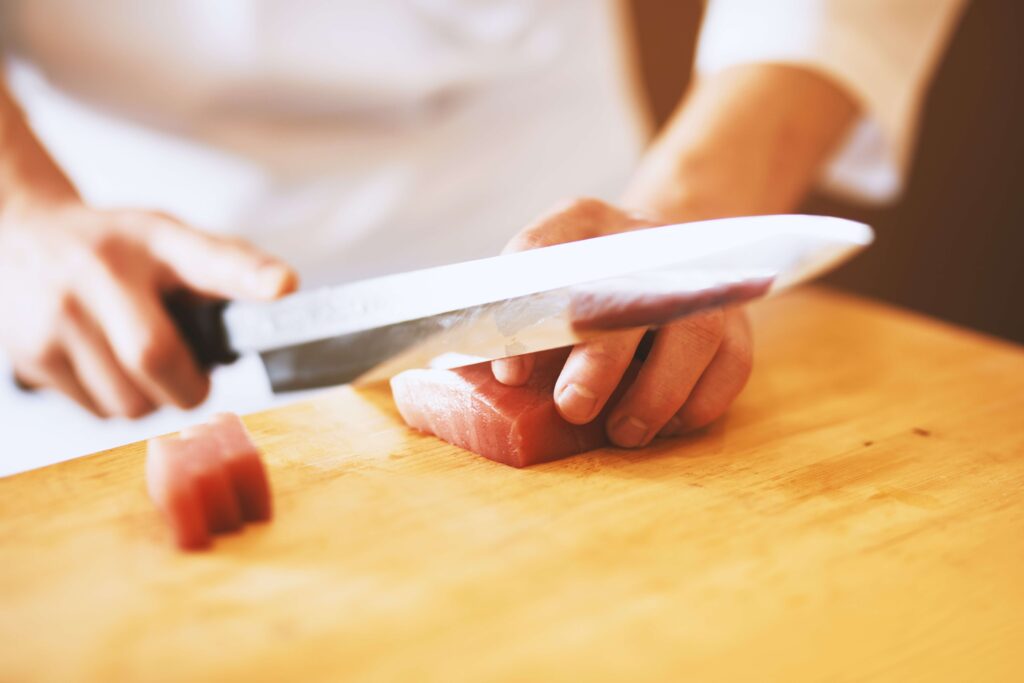
Kaiseki for All
At the heart of kaiseki cuisine lies omotenashi—the spirit of heartfelt hospitality—and a deep sensitivity to the seasons.
It is not simply about presenting luxurious dishes, but about crafting each plate with care and intention, tailored to the guest’s physical condition, values, and beliefs for that specific day.
At Ise Sueyoshi, we cherish the flexibility to serve every guest with equal thoughtfulness.
Whether your needs involve gluten-free, vegetarian, vegan, or religious dietary restrictions, we will accommodate your requests to the fullest extent possible. With advance notice, we are proud to adapt without ever compromising the essence of kaiseki.
For example, guests avoiding gluten will enjoy a course built on rich dashi broths and flavor foundations crafted without wheat-based seasonings or ingredients.
For those who do not consume meat, we offer dishes that celebrate the bounty of Japan’s nature—seasonal vegetables, seaweed, tofu, sesame tofu, and mountain plants—composed with finesse and respect.
We do not see such limitations as inconveniences, but rather embrace them with the philosophy that “true creativity is born within constraint.”
Even when core ingredients like fugu or wagyu cannot be used, we carefully select alternatives and fine-tune flavor, aroma, texture, temperature, and plating—ensuring the full course remains complete, cohesive, and deeply satisfying.
In fact, many guests with dietary restrictions tell us they leave with more delight than they ever expected, offering us both gratitude and inspiration.
True culinary technique shines brightest under limitations.
When certain ingredients are not available, it heightens the value of what can be done—and that is where cuisine evolves.
At Ise Sueyoshi, our kaiseki experience is open to all.
We warmly invite you to discover the essence of Japanese cuisine—through your own unique sensibilities.
For more about our vegan or vegetarian please visit this page.
For more about our gluten-free please visit this page.
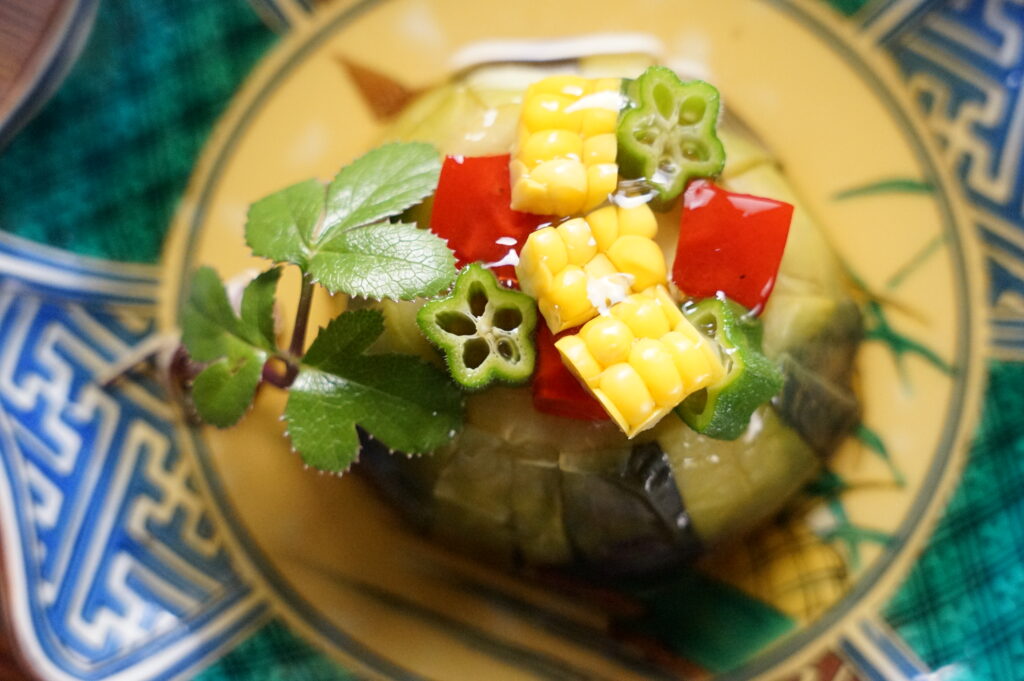
Globefish Memory
Fugu is not just a “delicacy.”
It is an experience that leaves an imprint—a single bite that lingers in your memory for a lifetime.
At Ise Sueyoshi, fugu is offered not as the centerpiece, but as a single seasonal dish within a ten-course kaiseki journey.
Its role is not to dominate the course, but to deliver a quiet yet piercing impression, like a well-placed note in a symphony.
By intentionally limiting fugu to just one dish, we preserve the tension, beauty, and sense of ichigo ichie—the unrepeatable magic of a once-in-a-lifetime encounter.
Many guests have shared their thoughts with us:
“It was the most delicious bite of my life.”
“That flavor appeared in my dreams.”
“I want to return to Japan again, just for this one dish.”
One guest even chose Ise Sueyoshi as the setting for a proposal, with the fugu course marking the emotional high point of that moment.
Another guest has visited from overseas—two, three times—always looking forward to experiencing our seasonal fugu in a new expression.
Each plate becomes a personal memory, tailored and sealed in the heart of its beholder.
During travel, a meal is not just nourishment.
It can become the emotional core of the journey—
a moment when rare ingredients, refined Japanese technique, the rhythm of the seasons, and a chef’s philosophy all align into something unforgettable.
If you are searching for
“a dish you’ll never forget,”
that answer may be found here.
Come discover your own unforgettable plate at Ise Sueyoshi.
It may just become one of the most beautiful, quietly stirring moments in your life.
🔗Many choose Ise Sueyoshi as a gift dinner for birthdays or honeymoons.
Learn more this article.
TRIPADVISOR REVIEW
Jun 2023
An impeccable Kaiseki Experience
What an impeccable #kaiseki experience – both culinary and culturally. We were only 4 people in the restaurant and Chef Yuuki Tanaka prepares everything from the seasonal ingredients from his hometown Ise. Our evenings theme was inspired from the “rain season” in Japan. We enjoy every bits of the food but the stand outs of the night are Fugu “puffer fish” and Ise Maguro sashimi, Matcha coated lobster, wagyu, milky clamps and matcha “soufflé” . If you are looking for special night out you won’t regret a second. Highly recommended !
We are proud to continue delivering an exceptional dining experience that earned us the Tripadvisor Travelers’ Choice Best of the Best 2024 award, ranking among the Best Restaurants in Tokyo. Our commitment to excellence in service and our dedication to offering the finest kaiseki dining experience in Tokyo remain unwavering. Discover more about our journey to becoming one of the best restaurants in the city[here].

Visit Ise Sueyoshi
Location: Conveniently located 12 minutes from Roppongi Station and 8 minutes from Hiroo Station.
Hours: Open 5:00 PM – 10:00 PM, reservations only. Closed on Sundays and Mondays.
Book Your Experience ☟
Reservation Information
In response to many requests from our guests, Ise Sueyoshi now accepts reservations up to 180 days in advance of your preferred dining date.
With only 10 seats available, we are committed to providing a smooth and personalized reservation experience.
To ensure you don’t miss the opportunity to celebrate your important anniversaries or special occasions with us, we highly recommend making your reservation as soon as your plans are set.
If you are planning a trip to Japan, we warmly invite you to include a special moment at Ise Sueyoshi in your itinerary.
Many of our guests also choose us for their final evening in Japan, as a beautiful and memorable way to conclude their journey.
Please note that our reservation policies may change without prior notice. For the latest updates, please refer to our reservation page.
Recommended Blog Posts
On our blog, we offer further insights into Tokyo’s rich food culture and the unique culinary experiences we provide at Ise Sueyoshi. Be sure to check out these recommended posts:
Best Kaiseki in Tokyo? Ise Sueyoshi Sets the Standard for an Authentic Experience
Where to Find the Best Vegetarian Kaiseki in Tokyo: Hidden Gem
@isesueyoshi
o Awarded the prestigious Best Luxury Restaurant by TripAdvisor
o Ranked 2nd worldwide, 1st in Japan, and 1st in Asia
o Google rating of 4.9 (as of 2024)
o Vegan-friendly
o Halal selections
o Gluten-free options
o Vegetarian delights
o Pork-free choices
o Perfect for pescatarians
o Welcoming and inclusive environment for LGBTQ guests
o Just a 12-minute walk from Roppongi Station or 8-minutes from Hiroo Station
o 5:00 PM – 10:00 PM (reservations-only)
o Closed on Sun and Mon
